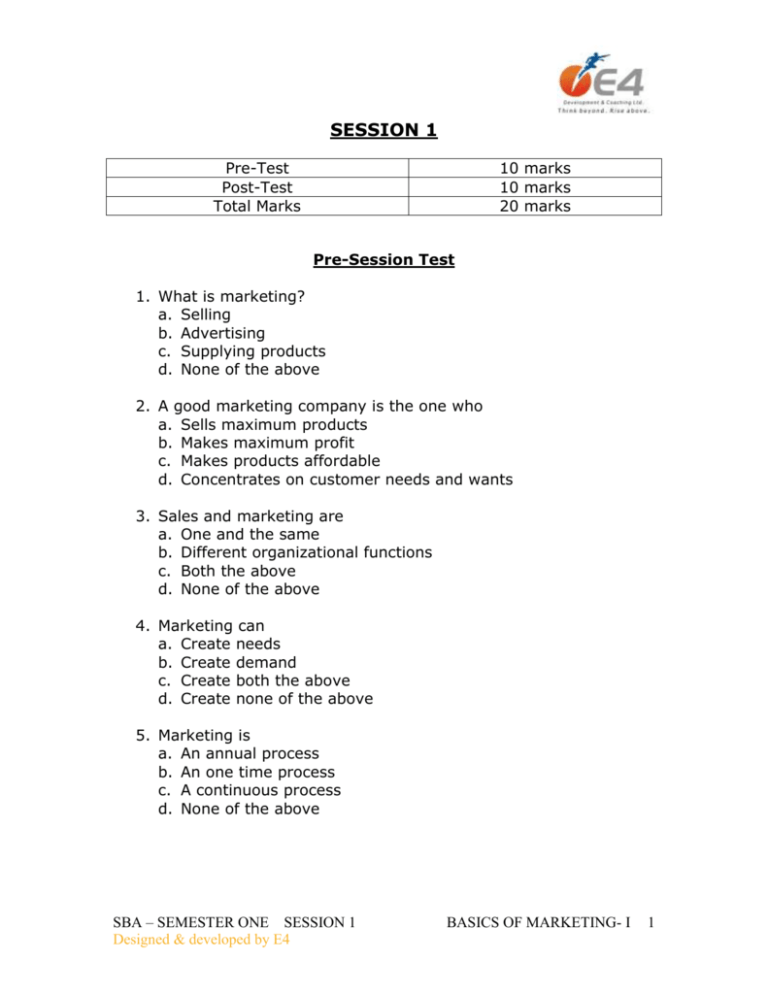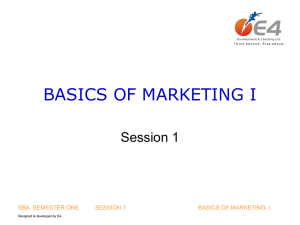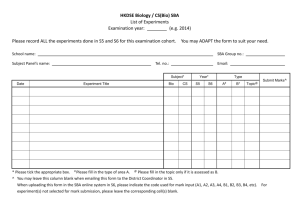session 1 understanding the marketing concept
advertisement

SESSION 1 Pre-Test Post-Test Total Marks 10 marks 10 marks 20 marks Pre-Session Test 1. What is marketing? a. Selling b. Advertising c. Supplying products d. None of the above 2. A good marketing company is the one who a. Sells maximum products b. Makes maximum profit c. Makes products affordable d. Concentrates on customer needs and wants 3. Sales and marketing are a. One and the same b. Different organizational functions c. Both the above d. None of the above 4. Marketing can a. Create needs b. Create demand c. Create both the above d. Create none of the above 5. Marketing is a. An annual process b. An one time process c. A continuous process d. None of the above SBA – SEMESTER ONE SESSION 1 Designed & developed by E4 BASICS OF MARKETING- I 1 6. Marketing is to sell at the a. Least price b. Highest price c. Price that delivers maximum customer value d. Lower than that of the competition 7. Customer forms basis of any marketing process a. True b. False c. Customers and competition form basis of any marketing process d. None of the above 8. One has to price their products lower than competition to sell in the marketplace a. True b. False c. Depends on products d. Can’t say 9. Marketers can increase customer value by a. Raise benefits b. Reduce costs c. Both the above d. None of he above 10. Needs are a. Basic human requirements b. Wants c. Demands d. All of the above SBA – SEMESTER ONE SESSION 1 Designed & developed by E4 BASICS OF MARKETING- I 2 1.1 Introduction Understanding of nature and scope of marketing function is critical for laying a strong foundation to a career in sales management. The marketing decisions form the basis of forming sales strategies and sales operational decisions. In this session, we will try to understand the concept of marketing, distinctively different than the sales concept. 1.2 Learning Objectives 1. Define the term marketing 2. To understand needs, wants and demand 3. Discuss the differences between sales and market orientations 4. Understanding customer value 5. Describe four marketing management philosophies 1.3 What is Marketing? American Marketing Association Definition Marketing is the process of planning and executing the conception, pricing, promotion, and distribution of ideas, goods, and services to create exchanges that satisfy individual and organizational goals. Kotler defines marketing as: Marketing management is the art and science of choosing target markets and getting, keeping and growing customers through creating, delivering and communicating superior customer value. SBA – SEMESTER ONE SESSION 1 Designed & developed by E4 BASICS OF MARKETING- I 3 1.4 The Marketing Concept Focuses on customer wants and needs to distinguish products from competition Integrates all organization’s activities to satisfy customer wants and needs Achieves organization’s long-term goals by satisfying customer wants and needs 1.5 Needs, Wants & Demands Needs are the basic human requirements. People need food, air, water, clothing and shelter to survive. People have also strong needs for recreation, entertainment and education. These needs become wants when they are directed to specific objects that might satisfy the need. An American needs food but wants hamburger, French fries and a soft drink. A person in India may need food but wants a daal -roti. Wants are shaped by one’s society Demands are wants for specific products backed by an ability to pay. Many people want a Mercedes only a few are able and willing to buy one. Companies must measure not only how many people want their product but also how many would actually be willing and able to buy it. These distinctions shed light on the frequent criticism that “marketers create needs” or marketers get people to buy things they don’t want. Marketers do not create needs. Needs pre-exist marketers. Marketers along with other societal factors influence wants. Marketers might promote the idea that Mercedes would satisfy a person’s need for social status. They so not however create the need for social status. Marketers can influence level, timing & composition of demand SBA – SEMESTER ONE SESSION 1 Designed & developed by E4 BASICS OF MARKETING- I 4 1.6 A Simple Marketing System Ref: Marketing Management by Philip Kotler The figure above shows the relationship between the industry and the market. Sellers and buyers are connected by four flows. The sellers send goods and services and communications (ads, direct mail) to the market in return they receive money and information (attitude and sales data). The inner loop shows an exchange of money for goods and services the outer loop shows an exchange of information. Exchange: Exchange is core concept of marketing. Exchange involves obtaining a desired product from someone by offering something in return. For exchange potential to exist, five conditions must be satisfied: At least two parties Each party has something that might be of some value to the other party. Each party is capable of communication and delivery Each party is free to accept or reject offer Each party believes that it is appropriate or desirable to deal with the other party. Exchange is value-creating process as it leaves both the parties NORMALLY better off. SBA – SEMESTER ONE SESSION 1 Designed & developed by E4 BASICS OF MARKETING- I 5 A transaction is a trade of values between two or more parties. Monetary transaction: Paying money in exchange of goods Barter transaction: Goods or services for other goods or services. Dimensions of a transaction: At least two things of value Agreed upon conditions A time of agreement Place of agreement Transaction differs from transfer. In a transfer A gives goods to B but does not receive anything tangible in return. Example: Gifts, charities, subsidies etc. 1.7 Contrasts between the Sales Concept and the Marketing Concept Ref: Marketing Management by Philip Kotler Theodore Levitt of Harvard drew a perspective contrast between the selling and marketing concepts: Selling focuses on the needs of the seller while marketing on the needs of the buyer. Selling is preoccupied with the seller’s need to convert his product into cash while marketing with the idea of satisfying the SBA – SEMESTER ONE SESSION 1 Designed & developed by E4 BASICS OF MARKETING- I 6 needs of the customer by the means of the product and the whole cluster of things associated with creating, delivering and finally consuming it. The marketing concept rests on four pillars: target market, customer needs, integrated marketing and profitability. The selling concept takes an inside-out perspective. It starts with the factory, focuses on existing product, and calls for selling and promoting to produce profitable sales. The marketing concepts take an outside-in-perspective. It starts with a well defined market, focuses on consumer needs, coordinates all the activities that will affect consumers, and produce profits by satisfying customers. 1.8 Customer Value Companies address needs of consumers by putting forth a value proposition a set of benefits they offer to customers to satisfy their needs. The intangible value proposition is made physical by an offering which can be combination of products, services, information and experiences. A brand is an offering from a known source. A brand name such as McDonalds carries many associations in the minds of people: hamburgers, fun, children, and fast food. These associations make up the brand image. All companies strive to build brand strength- that is a strong, favorable Value is a ratio between what the customer gets and what he gives Any product/service offering will be successful if it delivers “value” to the customer The buyer chooses between different offerings on the basis of what is perceived to deliver most value Value can be seen as primarily a combination of quality, service and price (QSP) called “customer value triad” Value increases with quality and service and decreases with price The benefits include functional benefits and emotional benefits The costs include monitory costs, time costs, energy costs and psychic costs SBA – SEMESTER ONE SESSION 1 Designed & developed by E4 BASICS OF MARKETING- I 7 Thus value is given by: Value = benefits/ costs = functional benefits + emotional benefits/ monetary costs+ time costs + energy costs + physic cost A similar expression of the above concept is as under : Ref: Marketing Management by Philip Kotler The marketer can increase the value of the customer offering in several ways: Raise benefits Reduce cost Raise benefits and reduce cost Raise benefits by more than the raise in costs Lower benefits by less than the reduction in costs SBA – SEMESTER ONE SESSION 1 Designed & developed by E4 BASICS OF MARKETING- I 8 1.9 Marketing Management Philosophies Production Production Sales Sales Competing Competing Philosophies Philosophies Market Market Societal Societal Marketing Marketing Ref: Marketing by Lamb Marketing Management Philosophies: Philosophy Production Sales Market Societal Key Ideas Focus on efficiency of internal operations Focus on aggressive techniques or overcoming customer resistance Focus on satisfying customer needs and wants Focus on satisfying customer needs and wants while enhancing individual and societal well-beingby Lamb Ref: Marketing Company orientation towards the market place We have defined marketing management as the conscious effort to achieve desired exchange with target markets. But what philosophy should guide a company’s marketing efforts? What relative weights should be given to the interests of the organization, the customers and SBA – SEMESTER ONE SESSION 1 Designed & developed by E4 BASICS OF MARKETING- I 9 the society? Very often these interest conflict. Clearly, marketing activities should be carried under a well-thought out philosophy of efficient, effective, and socially responsible marketing. However, there are four competing philosophies under which organizations conduct marketing activities: Production, Selling, marketing and societal The Production Concept: The production concept is the oldest concept in business. The production concept holds that consumers will prefer products that are widely available and inexpensive. Managers of production-oriented business concentrate on achieving high production efficiency, low costs and mass distribution. They assume that consumers are primarily interested in product availability and low prices. Some marketing thinkers also propose “Product concept” which involves offering superior products. The Selling Concept: The selling concept is another common business orientation. The selling concept holds that consumers and businesses, if left alone, will ordinarily not buy enough of the organizations products. The organization must, therefore, undertake an aggressive selling and promotion effort. This concept one assumes that consumers typically show buying inertia or resistance and must be coaxed into buying. It also assumes that the company has a whole battery of effective selling and promotion tools to stimulate more buying. The Marketing Concept: The marketing concept holds that the key to achieving its organizational goals consists of the company being more effective than competitors in creating, delivering, and communicating customer values to its chosen target markets. SBA – SEMESTER ONE SESSION 1 Designed & developed by E4 BASICS OF MARKETING- I 10 Societal Marketing Concept: The Societal Marketing Concept holds that the Organizations task is to determine the needs, wants and interests of target markets and to deliver the desired satisfaction more effectively and efficiently than competitors in a way that preserves and enhances the consumers and the societies well being. Many companies today are also moving towards “Customer concept”. This involves shaping separate offers, services, & messages for individual customers. Now you know: Marketing is all about creating & delivering relevant “value” to a chosen set of customers. Getting the above right is crucial not only for marketing function alone, but also for the entire business organization. SBA – SEMESTER ONE SESSION 1 Designed & developed by E4 BASICS OF MARKETING- I 11 Post-Session Test 1. Marketing is to a. Achieves organization’s long-term goals by satisfying customer wants and needs b. Help selling by creating advertisements c. Decide policies for pricing d. Make products available 2. Needs can be a. Converted in to wants b. Created c. Both the above d. None of the above 3. The selling concept focuses on a. Products b. Customers c. Competition d. None of above 4. The marketing concept focuses on a. Customer needs b. Creating awareness c. Maximizing sales d. All of above 5. Following is not one of the marketing philosophies a. Production b. Market c. Societal d. Regional 6. The starting point of marketing concept is a. The consumer b. The competitor c. The CEO d. The product SBA – SEMESTER ONE SESSION 1 Designed & developed by E4 BASICS OF MARKETING- I 12 7. Demands are a. Wants for specific products backed by the willingness & ability to pay b. Consumer expectations c. Consumers’ rights d. Needs 8. Marketers can alter the customer value perception in their favour a. True b. False c. True only in a few situations d. None of the above 9. The selling process focuses on a. Markets b. Customers c. Organization d. All of the above 10. Marketing focus on achieving organization’s a. Long term goles b. Short term goals c. Both of above d. None of the above SBA – SEMESTER ONE SESSION 1 Designed & developed by E4 BASICS OF MARKETING- I 13 Session-1 Solutions Pre-Session Test Ques. No. 1 2 3 4 5 6 7 8 9 10 Answer d d b b c c a b c a SBA – SEMESTER ONE SESSION 1 Designed & developed by E4 Post-Session Test Ques. No. 1 2 3 4 5 6 7 8 9 10 Answer a a a a d a a a a a BASICS OF MARKETING- I 14 REFERENCE MATERIAL Marketing Management(2nd Edition) Marketing Management(11th Edition) Marketing Management(Instructor’s Ppts’) 1. 2. 3. 4. AUTHORS PUBLICATIONS Rajan Saxena Tata McGraw Hill Philip Kotler Prentice Hall India Lamb Strictly for private circulation only. This work study booklet is meant for students only. The partial content & pictures used in this study booklet are for illustration purpose only. This work-study booklet is for classroom study reference only & is not for sale SBA – SEMESTER ONE SESSION 1 Designed & developed by E4 BASICS OF MARKETING- I 15




